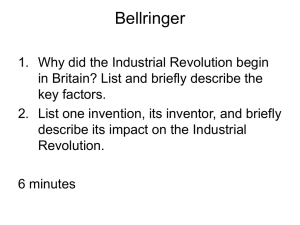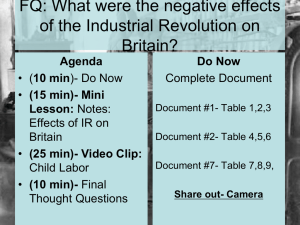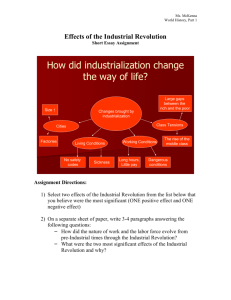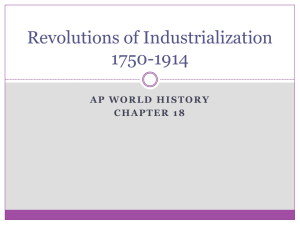Industrial Revolution Reading
advertisement
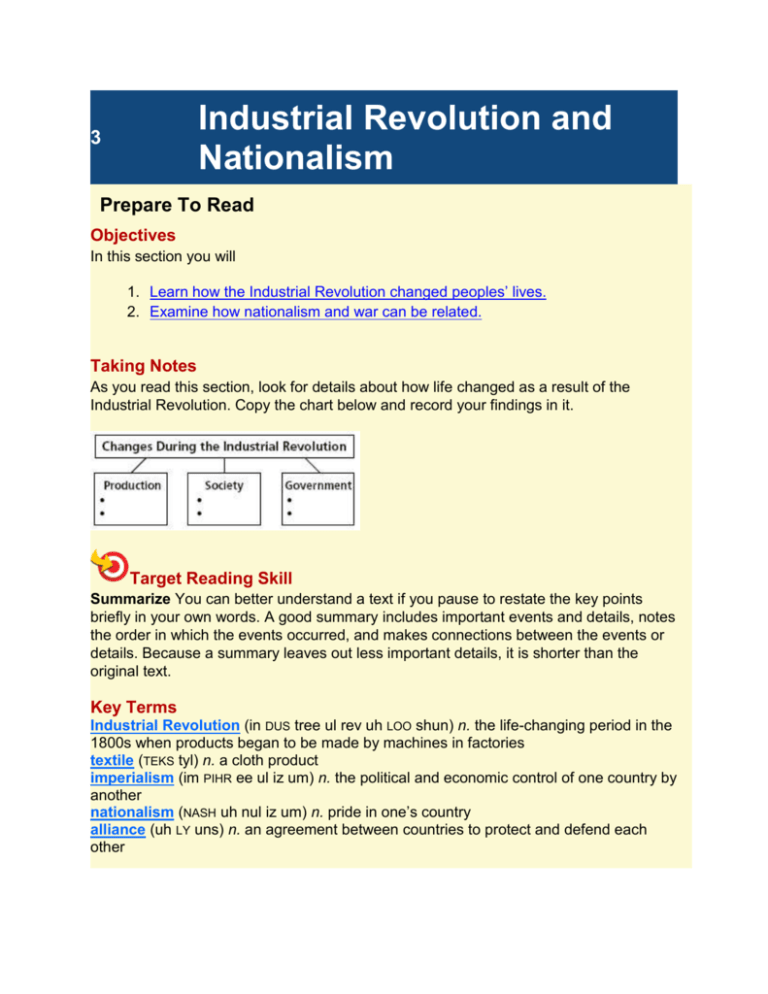
Industrial Revolution and Nationalism 3 Prepare To Read Objectives In this section you will 1. Learn how the Industrial Revolution changed peoples’ lives. 2. Examine how nationalism and war can be related. Taking Notes As you read this section, look for details about how life changed as a result of the Industrial Revolution. Copy the chart below and record your findings in it. Target Reading Skill Summarize You can better understand a text if you pause to restate the key points briefly in your own words. A good summary includes important events and details, notes the order in which the events occurred, and makes connections between the events or details. Because a summary leaves out less important details, it is shorter than the original text. Key Terms Industrial Revolution (in DUS tree ul rev uh LOO shun) n. the life-changing period in the 1800s when products began to be made by machines in factories textile (TEKS tyl) n. a cloth product imperialism (im PIHR ee ul iz um) n. the political and economic control of one country by another nationalism (NASH uh nul iz um) n. pride in one’s country alliance (uh LY uns) n. an agreement between countries to protect and defend each other It was dawn. Thick, black smoke rose from the tall smokestack of the factory. The smoke and the roar of machines signaled that the factory workday had begun. Inside, women and children worked at rows of machines that wove cotton thread into cloth. Their work was dirty, noisy, and dangerous. The day before, a worker had severely injured his hand in a machine. Today, another worker stood in his place. Both were only 13 years old. But the machines kept going. Workers fed them thread for 12 hours every day—six days a week. Vacations did not exist, and there were few breaks. Factories like this one could be found all across Europe in the early 1800s. They were a result of the Industrial Revolution, a life-changing period when goods changed from being made by hand to being made by machines in factories. Industrialization caused great suffering at first, but in time brought an easier way of life to people all over the world. Workers grind razors at a factory in Sheffield, England, in 1866. Chapter 2, Section 3 The Industrial Revolution Until the late 1700s, nearly all goods were made by hand. People made what they needed, or bought it from a craftsperson or at a store for a high price. The Industrial Revolution—a revolution in the way goods were made and in the ways people lived and worked—changed all that. Changes in Production The first machines of the Industrial Revolution were invented in Great Britain to speed up the weaving of textiles, or cloth products. Large factories housed the machines. Factory work was very different from work done by hand. For example, a person weaving cloth would first spin the thread, then dye it, and then weave it. He or she might work on every step of the finished product. In contrast, in a factory each worker tended a specific machine, which performed a specific job over and over again. The machine worked much faster than a person could. This meant that goods could be made quickly and much more cheaply than they had been by hand. This new factory system was improved by new inventions in machinery, transportation, and communication. Other new inventions also brought about improvements in agriculture. Food could be grown in larger quantities by fewer people, and transported quickly to supply factory workers in the cities. Improvements in Making Cloth For generations, people used spinning wheels like the first photo to spin cloth. After the Industrial Revolution, huge machines called “spinning mules” in factories like the second photo produced cloth cheaper and more quickly. Evaluate Information How do you think the shift from using simple tools to complex machinery affected the average worker? Changes in Society Because Great Britain’s factories were so successful, business people in other countries began to build factories. By 1900, factories produced many of the goods made in the United States and Western Europe. The Industrial Revolution changed life in almost every way. Inventions created to fuel the Industrial Revolution were soon used in everyday life. Improved transportation meant that people could travel more quickly and often more cheaply. Better communications meant that people separated by long distances could talk to one another almost instantly. Yet not all of the effects of the Industrial Revolution were positive. For hundreds of years, families had farmed the land. Now they moved to industrial centers to work in factories. Cities grew rapidly. People lived in cramped, dirty housing. Because of unclean and crowded conditions, diseases spread rapidly. Factory work was also difficult. Factory owners took advantage of workers. Wages were low. Factory conditions were not safe. However, workers slowly began to form labor unions and to demand better working conditions. In the early 1900s, governments began passing laws to protect workers. Over time, conditions improved and wages rose. The Industrial Revolution helped give working people a greater voice in government. Many European nations became more democratic as a result. Changes in Government At the same time, though, European governments were becoming more aggressive abroad. Beginning in the 1600s, many European nations had followed the policy of imperialism, or taking over other countries and turning them into colonies. Colonies provided the raw materials, such as cotton, wood, and metals, that industry needed. Colonies also supplied markets for European goods. Finally, European countries hoped to spread their influence over people in those colonies by converting them to their own religions. Target Reading Skill Summarize Summarize the paragraph above. Give the main point and two details. The late 1800s are called the Age of Imperialism. During this time, the nations of Belgium, France, Italy, Spain, Portugal, Germany, and Great Britain colonized most of Africa. Some of these countries also took over much of Southeast Asia and many South Pacific islands. In time, struggles among the colonial powers would bring disaster to Europe. Chapter 2, Section 3 A Century of War and Nationalism At the start of the 1900s, the people of Europe were filled with nationalism, or pride in their countries. Nationalism can be either a destructive or a constructive force, depending on what it leads people to do. It can make one nation harm another in an effort to get ahead. It can also prevent nations from working with one another. Then, hatred and warfare can erupt between countries. Between 1900 and 1950, destructive nationalism played a part in causing two world wars and the deaths of millions of people. World War I During the early 1900s, European nations feared one another. Each nation was afraid another would invade, or try to take over, its territory. To protect themselves, nations made alliances (uh LY un sez), or agreements with one another. In such alliances, a nation promises to protect its friends if someone attacks them. Soon, Europe was divided into two major alliances. On one side were Germany, Austria-Hungary, and Turkey. On the other side were Great Britain, France, and Russia. In 1914, fighting between the alliances broke out into what is now called World War I. Over the course of the war, most of the nations of Europe became involved. The United States—on the side of Great Britain, France, and Russia—also joined the war in 1917. The alliance of Germany, Austria-Hungary, and Turkey was defeated, but at an enormous cost. By the end of the war in 1918, more than 9 million soldiers had been killed. About 13 million civilians, or non-soldiers, had also died. Europe had lost almost an entire generation of young men. During World War I, countries on both sides of the fight used posters to promote their causes. World War II But the flame of nationalism still burned. In 1939, another war broke out. This war was called World War II. As in World War I, there were two alliances. On one side were the Axis Powers—Germany, Italy, and Japan. These countries sought to increase their national wealth and power by means of military conquest. They quickly captured most of Europe and parts of China and the South Pacific. Germany also attacked the Soviet Union. The Allies—Great Britain, the Soviet Union, France, and China—opposed the Axis Powers. In 1941, the United States joined the Allies. More than 50 nations took part in this war, which was the most destructive ever fought. More people died, more property was damaged, and more money was spent than in any other war in history. The fighting finally ended in August of 1945. The Allies had won. Two Paths Emerge in Europe After World War II, the Soviet Union and the United States emerged as the world’s two superpowers. These nations had very different ideas about government and its role in society. Both nations used their ideas to influence people around the world. After the war, much of Europe was in ruins. It was time to rebuild. The nations of Western Europe allied themselves with the United States. They also grew together as a region. With the shared values of peace and prosperity, they worked together to restore the economies and standards of living that had been shattered by war. The nations of Eastern Europe, in contrast, took a different path. Many of the nations of Eastern Europe followed the example of the Soviet Union. Their economies failed to recover after the war, and their governments suspended many of their people’s freedoms. You will read more about the Soviet Union and its influence on Eastern Europe in the next section. Eastern and Western Europe remained divided, with very different governments and standards of living, until the 1990s. You will read about their recent history in Chapters 4 and 5. The United States led an effort called the Marshall Plan to rebuild the economies of Europe. In this photo, a parade in Greece celebrates the delivery of Marshall Plan food supplies. Reading Check Which countries made up the Axis Powers? Which made up the Allies?




